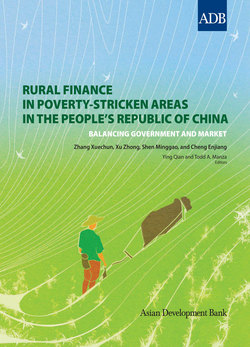Читать книгу Rural Finance in Poverty-Stricken Areas in the People's Republic of China - Xuechun Zhang - Страница 34
На сайте Литреса книга снята с продажи.
Phase 5. Rural Financial Reform and Liberalization
ОглавлениеIn recent years, the PRC has been developing rapidly and rural income has been growing quickly. From 2001 to 2004, total savings in rural areas increased from nearly CNY4 trillion to nearly CNY7 trillion, yielding a CNY1 trillion yearly increase in rural savings. RCC savings accounted for 40% of total rural savings, the ABC accounted for nearly 20%, and other banks represented around 30%. Postal savings accounted for around 10% of total rural savings, with the percentage varying from region to region. The gap between total rural savings and loans widened to about CNY2 trillion in 2004, accounting for half of total rural loans.
The major functions of the RCC union include providing management, coordination, and services to the RCCs in the county
The formal finance sector in rural PRC currently comprises the ABC, the ADBC, RCCs, and rural postal savings.5 Rural postal savings financial institutions are savings-only. The ABC, RCCs, and postal savings have outlets at the county level and below. RCCs are the main force in rural finance and township RCCs are categorized as independent legal persons and profit centers. Many RCCs have credit and savings stations and agents in the villages. At the county level, RCCs are represented by a union that, with shares from individual RCCs in the county, also is a profit center and a legal person. The township RCCs report to both the RCC union and the county branch of the PBC. The major functions of the RCC union include providing management, coordination, and services to the RCCs in the county. Since 2000, the ABC has closed many outlets, including 8,601 in the central PRC (a decrease of 39.3%) and 4,635 in the western PRC (a decrease of 31.9%). Under its strategic restructuring, the ABC has focused on commercial financing in counties and cities.
ADBC has outlets in 1,606 counties, though none in the poorest regions, and its function has shifted from comprehensive loans to crop-acquisition loans. With the market-oriented reform of the grain and cotton circulation system, the monopoly of state-owned enterprises in this area has been broken. This has reduced ADBC business in some regions, ending the supply of development financial services and leaving the RCCs as the major player in rural finance, although RCCs can only meet basic financial demand for agricultural production in most regions.
Rural financial institutions’ deposits and loans are not entirely rural deposits and loans. As financial institutions based at the township level, however, the operations of RCCs have been restricted to rural areas. Therefore, all RCC deposits and loans can be regarded as rural deposits and lending.6 ADBC loans, which are used for the procurement, storage, and processing of important farm goods (mainly grain), have been officially defined as rural lending, although the benefits brought about by such policy loans are far from restricted to rural areas.
The PRC’s gradual rural financial reform has been demand-oriented. When the rural economy was dominated by township and village enterprises, collective credit dominated. At the time, the ABC and RCCs were instrumental in supporting township and village enterprises. In early 1990s, when township and village enterprise reform began, private enterprises in a few regions witnessed rapid growth and individual credit gradually overtook collective credit in rural areas. To some extent, the commercialization of the ABC, the separation of RCCs from the ABC, the introduction of collateral and various guaranties, and new financial products such as microfinance based on individual creditworthiness and collective guaranty addressed the contradiction between state-owned and collective financial systems and individual credit. Rural finance played a positive role in supporting the development of private enterprises and small-scale industrial and commercial entities.
However, a number of problems emerged during the course of reform. For instance, a great number of nonperforming loans built up during the process of township and village enterprise reform and the transition from collective to individual credit. With the gradual exit of state-owned commercial banks from the rural financial market and the overhaul of rural cooperative foundations, RCCs became monopolies in the rural financial market. A large amount of money departed rural areas through rural financial institutions. RCC reform thus failed to change the foundations of rural financial institutions and particularly failed to address poor RCC governance.
